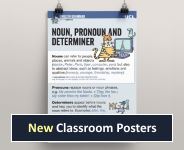Genre of Narratives and Recounts
Goals:
- Distinguish recounts from narratives
- Identify the discourse structure and features of register used in narratives
- Re-order a narrative by following the appropriate features
Lesson Plan
Before this lesson, you may want to complete the lesson An Introduction to Genre, so that learners are familiar with the key terms discourse structure and register
Please check if there are any hand outs at the bottom of this page and print in advance.
Explain that this lesson will focus on how we use genre to describe events. As a warmer, you could ask the learners to discuss what different ways there are to describe events and what makes each one different.
Start with the first slide for Activity 1. Ask learners what they know about narratives and recounts; then, give the explanation. Read the extract in slide 3 (also shown on the handout), and ask the learners whether it is a narrative or recount (recount is the correct answer). Ask learners how they could tell it was a recount (answer: it is purely factual and relate events in the past tense in order but without explaining motivations or consequences).
Move on to Activity 2 by asking learners to read the narrative titled Nature can be kind. The text is included in the printable document below. Ask learners what makes this different from the recount (the narrative is fictional and goes into more depth about cause and effect and the characters' feelings and motivations).
Remind learners of the definition of discourse structure. Ask them to discuss in pairs or small groups what they think the main structural elements of the narrative are, and why are they presented in this order.
Next, show the learners the discourse structure slide. They can find their own copy in the handout with more detailed definitions.
To check this knowledge, ask learners to complete the next activity. Without looking back at the original narrative, ask learners to put the six sentences in the correct order. They should use the narrative discourse structure handout to help. Learners can check their answers by looking back at the narrative. (Answer: E, C, B, F, A, D)
In Activity 3, ask learners to recall the definition of register. Tell them that particular features of language are used in narratives. In the next activity, learners must choose the correct grammatical terminology for the four phrases. Next, discuss where each one appears in the narrative and why they think they appear in this order. In the next activity, learners can confirm their ideas by revealing the answers 1-4.
The final aspect to analyse is evaluations in Activity 4. These appear throughout the text, rather than in one section. Ask the learners to look at the example, and find others in the narrative. Next, look at the four examples and identify what register features are used. Finally, Discuss why these features are used and show the answer on the last slide.
Activity 5 starts by using the hand out. Show the learners the out-of-order sentences that make up a new narrative (if you have time, you could cut these out as a hands-on re-ordering activity). Ask learners to put these sentences in the correct order, following the narrative discourse structure and features of register as guides.
- Learners can label each sentence with the appropriate discourse structure
- Learners can label the grammatical features to help them order the sentences
To check the learners' work, reveal the final slide. The learners may not have the exact same order, but it should follow the structure of a narrative and make sense! (Suggested order: E, C, F, D, B, K, J, A, L, G, H, I)
Further Work
As an extension, ask learners to plan and write their own narratives. Make sure they use the discourse structure and features of register as seen in the previous examples.
Acknowledgment
This series of resources explores how genre relates to grammar. The content of the lessons was devised and kindly provided by Prof. Andrew Goatly. You can find some of his publications for purchase on the Amazon website here.
Welcome!

Englicious is totally free for everyone to use!
But in exchange, we ask that you register for an account on our site.
If you’ve already registered, you can log in straight away.
Since this is your first visit today, you can see this page by clicking the button below.
- Printer-friendly version
- Log in to view or leave comments

